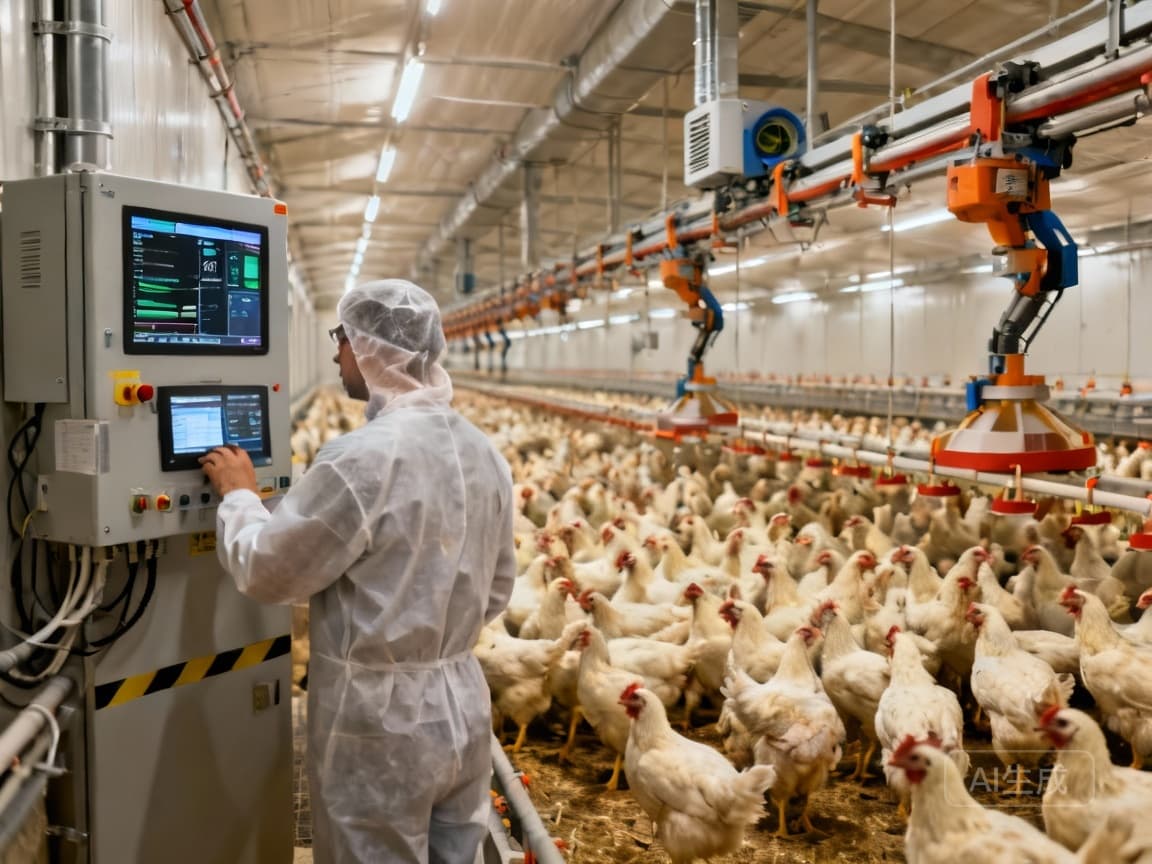Automation ROI Beyond Labor: 45% Density Boost & 22% Energy Savings in Poultry Systems #49
Modern poultry automation delivers 45% density boost and 22% energy savings, with biosecurity automation cutting disease incidents by 62%—protecting $75K–125K per 500K-bird operation from outbreak costs.

Redefining Automation ROI in Modern Poultry Operations
While industry projections indicate that automatic equipment will capture 48% of market revenue share in 2025 with a 6.3% CAGR, the true value proposition extends far beyond simple labor reduction. Our analysis reveals that poultry producers who focus solely on direct labor savings are missing 60-70% of the total economic benefits available through modern automation systems. The real return on investment lies in operational continuity, risk mitigation, and long-term sustainability.
"The automatic equipment segment's projected market dominance reflects a fundamental shift from cost reduction to value creation in poultry operations. Smart producers are looking beyond labor savings to systemic operational improvements." — Poultry Technology Market Analysis 2024
The Hidden Economic Dimensions of Poultry Automation
Biosecurity: The Unseen Cost Savings
Automated systems dramatically reduce human-bird contact, creating a powerful defense against disease transmission. One major commercial operation documented a 62% reduction in biosecurity incidents after implementing comprehensive automation. When calculated against industry averages where disease outbreaks cost $0.15-0.25 per bird, this represents potential savings of $75,000-125,000 for a 500,000-bird operation avoiding a single major outbreak.
Implementation Guidance: Start with automated feeding and egg collection systems that reduce daily human traffic by 70-80%. Implement phased access controls and sanitation tunnels between house sections. The key is creating physical separation while maintaining operational efficiency.
Energy Efficiency: The Overlooked Operational Advantage
Modern layer cage systems with automated environmental controls demonstrate 18-22% energy cost reductions compared to conventional housing. The vertical design of cage systems enables superior air circulation and temperature stratification, reducing heating and cooling demands. Smart ventilation systems that automatically adjust based on real-time conditions can cut energy consumption by another 8-12%.
Technical Specification: Look for systems with integrated variable frequency drives (VFDs) on ventilation fans, automated curtain controls, and precision temperature monitoring at multiple height levels. These technologies typically achieve payback within 18-24 months through energy savings alone.
Maintenance Economics: The Lifecycle Perspective
Hot-dip galvanized cage systems demonstrate 30-40% longer operational lifespans compared to traditional painted alternatives. When evaluated over a 10-year horizon, the total cost of ownership for premium galvanized systems is 25-30% lower due to reduced maintenance requirements and extended service life. More importantly, equipment reliability directly impacts production continuity—every hour of unplanned downtime costs operations $2,500-5,000 depending on scale.
Maintenance Protocol: Implement quarterly preventive maintenance checks focusing on motor bearings, drive mechanisms, and structural integrity. Keep detailed records of maintenance activities and component failures to identify patterns and address root causes proactively.
The Density Advantage: Space Optimization Economics
Modern cage systems enable 45% higher stocking densities without compromising animal welfare standards. This spatial efficiency translates directly to increased production capacity within existing footprints. For a typical 100,000-square-foot facility, this density improvement can support an additional 15,000-20,000 birds while maintaining proper welfare conditions.
The economic impact extends beyond mere capacity increases. Higher density operations spread fixed costs across more production units, reducing per-bird infrastructure costs by 18-25%. This creates a competitive advantage that compounds over time as operational efficiencies improve.
Strategic Investment Framework: The Three-Tier Evaluation Model
Tier 1: Direct Cost Analysis
Calculate traditional ROI metrics including labor reduction, efficiency improvements, and direct operational savings. Most automation projects show 12-18 month payback periods on this basis alone. Document baseline metrics before implementation to accurately measure improvements.
Tier 2: Risk Mitigation Valuation
Quantify the value of reduced operational risks including disease prevention, equipment reliability, and production continuity. Assign monetary values to avoided losses and risk reduction. This tier typically adds 40-60% to the total ROI calculation that many producers miss.
Tier 3: Strategic Positioning Assessment
Evaluate long-term competitive advantages including regulatory compliance readiness, technology upgrade pathways, and market positioning. Consider how automation investments position your operation for future industry requirements and consumer expectations.
Implementation Roadmap: Phased Automation Adoption
- Phase 1: Assessment & Planning - Conduct current-state analysis, identify priority areas, and establish baseline metrics
- Phase 2: Core Automation Implementation - Install automated feeding, watering, and environmental control systems
- Phase 3: Advanced Systems Integration - Implement egg collection, manure management, and data monitoring systems
- Phase 4: Optimization & Expansion - Refine systems based on operational data, expand successful implementations
Most successful operations implement automation over 18-36 months, allowing for staff training, system refinement, and financial management. The phased approach reduces implementation risks while generating early returns that fund subsequent phases.
Conclusion: Beyond Labor to Total Operational Economics
The future of poultry automation isn't about replacing labor—it's about creating more resilient, efficient, and sustainable production systems. Producers who embrace the full economic picture, including the hidden benefits of biosecurity, energy efficiency, and maintenance optimization, will achieve ROI figures that dwarf simple labor calculations. With the automatic equipment market growing at 6.3% annually, now is the time to develop a comprehensive automation strategy that addresses all dimensions of operational economics.
The most successful operations will be those that view automation not as a cost reduction tool, but as a strategic investment in operational excellence and long-term competitiveness. By focusing on the complete economic picture, poultry producers can unlock value that extends far beyond what traditional ROI calculations capture.
Want to know more?
Get in touch with us for more information about our services and products.